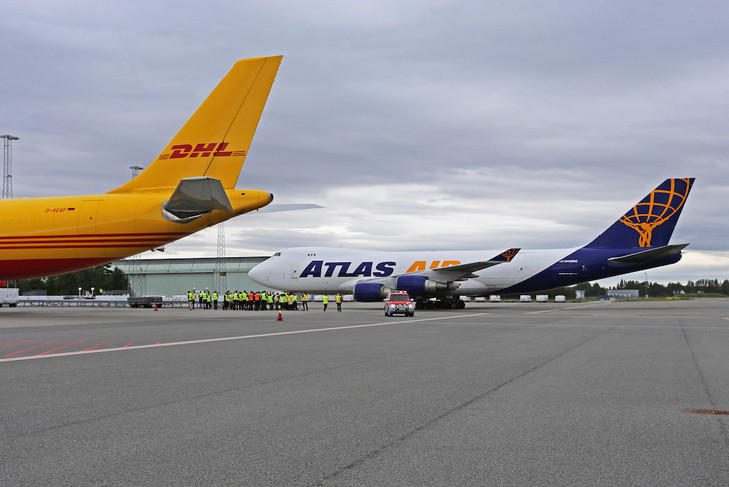DHL Global Forwarding looks to expand dedicated freighter service
11 / 06 / 2018

DHL Global Forwarding (DHL GF) is looking at addition routes with dedicated freighters, providing steady and predictable cargo uplift on trunk routes for customers as demand continues to outpace capacity.
David Goldberg, chief executive of DHL Global Forwarding in the US, said that the global economy looks set to continue a growth path, which started in 2017, and which requires a mix of commercial uplift in bellyholds and chartered maindeck capacity.
“If you reference the DHL Trade Barometer, we forecast that markets like the US will continue to increase, and as the market-leading airfreight forwarder we just can’t live on commercial capacity.
“We need to be able to provide steady and predictable service levels but also steady rates to our customers throughout the year.”
He continued: “The industry saw rates going up drastically last year, especially Asia inbound in the fourth quarter and also on US outbound. Airline capacity was cancelled at certain points of the year which caused immense problems.
“And with the types of volumes we have, if you cancel just one rotation, it is already a significant issue for us and our customers. So we deploy our own capacity on those lanes where we are sure we have the capacity to fill the flights.”
Goldberg added: “Shippers have a right to be demanding because supply chain lead times are becoming shorter and shorter. People are paying for airfreight and so they base their production around that and expect that the cargo will turn up when they need it.
“We just cannot live with a service where rotations are cancelled, where there is no place to put the demand and the cargo is delayed. Predictability is a major concern of shippers.”
DHL currently has B747 freighters, operated exclusively on its behalf by Atlas Air, operating between Shanghai (PVG) and Cincinnati (CVG) airports, but the world’s largest airfreight forwarder is also considering flights to Los Angeles and Incheon.
The demand is primarily China-driven said Goldberg, adding: “We also need different ways to connect the rest of Asia or some of the outbound flights which then go on to Europe.”
Goldberg said that e-commerce is “changing the landscape of airfreight,” and that after the 2008 financial crisis many supply chains were reorganised to ocean freight.
“We looked at what would be the next driver of demand in airfreight, because previously it was based on technology or pharmaceuticals, but the real driver of demand now is e-commerce.
“E-commerce is not one stand-alone sector, because it ranges across all different industry segments, with all different models of shipping. If you look at different markets around the world, taking Hong Kong for example, up to 60% of its total freight is now e-commerce related.”
DHL Global Forwarding will still rely on bellyhold capacity in passenger aircraft as a key component of its airfreight logistics, said Goldberg.
“Commercial uplift and bellyhold will remain a huge and significant portion of our total tonnage, so there is no shift away from bellyhold capacity.
“But on those trunk routes, where the capacity is constrained and we have the demand, then we have to be able to provide a competitive, predictable service throughout the year to our customers.
“It is the right move to inject some of our own capacity on those trunk routes and I think that is one of the reasons why customers use DHL. There are many forwarders in the market trying to access bellyhold capacity, and that is where we make use of our leading position, to be able to offer customers something special, something additional. That is one of DHL’s selling points.”
E-commerce volumes are challenging every aspect of the air cargo supply chain at airports, especially in the US, where airlines have outsourced ground handling to agents.
Added Goldberg: “As a general statement, ground handling in the US is not to the levels it needs to be. The cargo recovery times from the airlines are, in my opinion, far too long and we need to find solutions to be able to do it more quickly.
“We have seen, throughout the year, recovery times of six, seven or eight hours which is almost a whole shift for one person, and that is just far too long.
“We have taken some actions on our side, to try to improve to recover cargo more quickly, but there is a lot of work to be done to improve the speed in the US generally.”
Goldberg recognises that e-commerce is changing rapidly the challenges for air cargo, but that also means new ideas and new concepts coming in that will make the industry more efficient.
Better use of packaging for e-commerce, making it more “form-fitting” for the goods inside will see a better use of space in aircraft, which is greener and better for the environment but which also gives a better cost for customers.
The industry consensus is that 2018’s end of year peak season will at least match the bumper air cargo demand of 2017, with good omens already in the 2018 second quarter.
Observed Goldberg: “Let’s just say that our freighters are full, and we have not yet reached the peak season.
“I would predict that the fourth quarter of this year will be as strong as 2017. I have met with many customers and everybody is bright about a very strong fourth quarter, driven by e-commerce.
“It happened last year, again on the back of e-commerce, and I do not see how that would change this year.”
That market view is based upon DHL GF asking customers to give more forecasts for demand, and “better forecasts mean better service,” said Goldberg.
“It is just an issue of focus. Companies know what they are producing and what is going out. The information does not have to be perfect, but at least a better level of forecasting than we historically seen would be most helpful.”
Read more freight forwarder news














